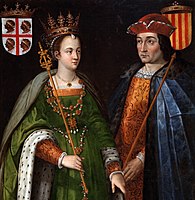| Kingdom of Aragon Reino d'Aragón (Aragonese) Regne d'Aragó (Catalan) Regnum Aragonum (Latin) Reino de Aragón (Spanish) | |||||
| |||||
In red, the modern territory of Aragon within Spain
| |||||
| Capital | Jaca, Huesca, Zaragoza (in chronological order) | ||||
| Languages | Aragonese, Catalan, Spanish, and Latin | ||||
| Religion | Roman Catholicism | ||||
| Government | Feudal monarchy | ||||
| Historical era | Middle Ages | ||||
| - | County of Aragon established as independent kingdom | 1035 | |||
| - | Nueva Planta decrees dissolved Aragonese institutions in 1707 | 1706 | |||
| Today part of | |||||
The Kingdom of Aragon (Aragonese: Reino d'Aragón, Catalan: Regne d'Aragó, Latin: Regnum Aragonum, Spanish: Reino de Aragón) was a medieval and early modern kingdom in the Iberian Peninsula, corresponding to the modern-day autonomous community of Aragon, in Spain. It should not be confused with the larger Crown of Aragon, that also included other territories — the County of Barcelona and other Catalan Counties, the Kingdom of Valencia, the Kingdom of Majorca, and other possessions nowadays part of France, Italy, and Greece — that were also under the rule of the King of Aragon, but were administered separately from the Kingdom of Aragon.
History[]
Independent kingdom[]
Aragon was originally a Carolingian feudal county around the city of Jaca, which in the first half of the 9th century became a vassal state of the kingdom of Pamplona (later Navarre), its own dynasty of counts ending without male heir in 922. The name Aragón is the same as that of the river Aragón, which flows by Jaca. It might derive from the Basque Aragona/Haragona meaning "good upper valley" ("haran+goi+ona", where "haran" = valley, "goi"= upper, high, and "ona"= good).
On the death of Sancho III of Navarre in 1035, the Kingdom of Navarre was divided into three parts: (1) Pamplona and its hinterland along with western and coastal Basque districts, (2) Castile and (3) Sobrarbe, Ribagorza and Aragon. Sancho's son Gonzalo inherited Sobrarbe and Ribargorza, whereas his illegitimate son Ramiro received Aragon, but Gonzalo was killed soon after and all the land he owned went to his brother Ramiro, thus becoming the first de facto king of Aragon,[1] although he never used that title.
By defeating his brother, García Sánchez III of Navarre, Ramiro achieved independence for Aragon. His son Sancho Ramírez, who also inherited the kingdom of Navarre, was the first to call himself "King of the Aragonians and Pamplonese".[2] As the Aragonian domains expanded to the south, conquering land from Al Andalus, the capital city moved from Jaca to Huesca (1096), and later to Zaragoza (1118). After Alfonso the Battler died childless in 1135, different rulers were chosen for Navarre and Aragon, and the two kingdoms ceased to have the same ruler. By 1285 the southernmost areas of what is nowadays Aragon had been taken from the Moors.
Dynastic union with Catalonia[]
The Kingdom of Aragón gave the name to the Crown of Aragon, after the dynastic union in 1150 of the Queen of Aragon (Petronilla of Aragon) with a Count of Barcelona (Ramon Berenguer IV), their son inheriting all different territories in the House of Aragon and the House of Barcelona. The Kings of Aragon had also the title of Count of Barcelona and ruled territories that consisted of not only the present administrative region of Aragon but also Catalonia, and later the kingdoms of Majorca, Valencia, Sicily, Naples and Sardinia. The King of Aragón was the direct King of the Aragonese region, and held also the title of Count of Provence, Count of Barcelona, Lord of Montpellier, and Duke of Athens and Neopatria. Each of these titles gave him sovereignty over a certain region, and these titles changed as he lost and won territories. In the fourteenth century, his power was greatly restricted by the Union of Aragon.
The Crown of Aragon became a part of the Spanish monarchy after the dynastic union with Castile, which supposed the de facto unification of both kingdoms under a common monarch. After this happened, Aragon kept its own institutions, such as the Corts, until the Nueva Planta decrees, promulgated between 1707 and 1715 in the aftermath of the War of the Spanish Succession, finally put an end to it.[3] The decree removing the rights of Aragon and Valencia was issued in 1707.[4] A new Nueva Planta decree in 1711 restored some rights in Aragon, such as the Aragones Civil Right, but preserved the end of the political independence of the kingdom.[4]
See also[]
- List of Aragonese monarchs
- List of Aragonese consorts
- List of Navarrese monarchs
- List of Counts of Barcelona
Notes[]
- ^ CAI Tourism of Aragon. Retrieved 2010-03-05
- ^ Antonio Ubieto, Creación y desarrollo de la Corona de Aragón, Anubar, Zaragoza, 1987, pp. 58-59.
- ^ I. Ruiz Rodríguez, Apuntes de historia del derecho y de las instituciones españolas, Dykinson, Madrid, 2005, p. 179. (In Spanish)
- ^ a b Albareda Salvadó, Joaquim (2010). La Guerra de Sucesión de España (1700-1714). Barcelona: Crítica. pp. 228-229. ISBN 978-84-9892-060-4.
Template:Spanish Kingdoms
| This page uses content from the English language Wikipedia. The original content was at Kingdom of Aragon. The list of authors can be seen in the page history. As with this Familypedia wiki, the content of Wikipedia is available under the Creative Commons License. |



